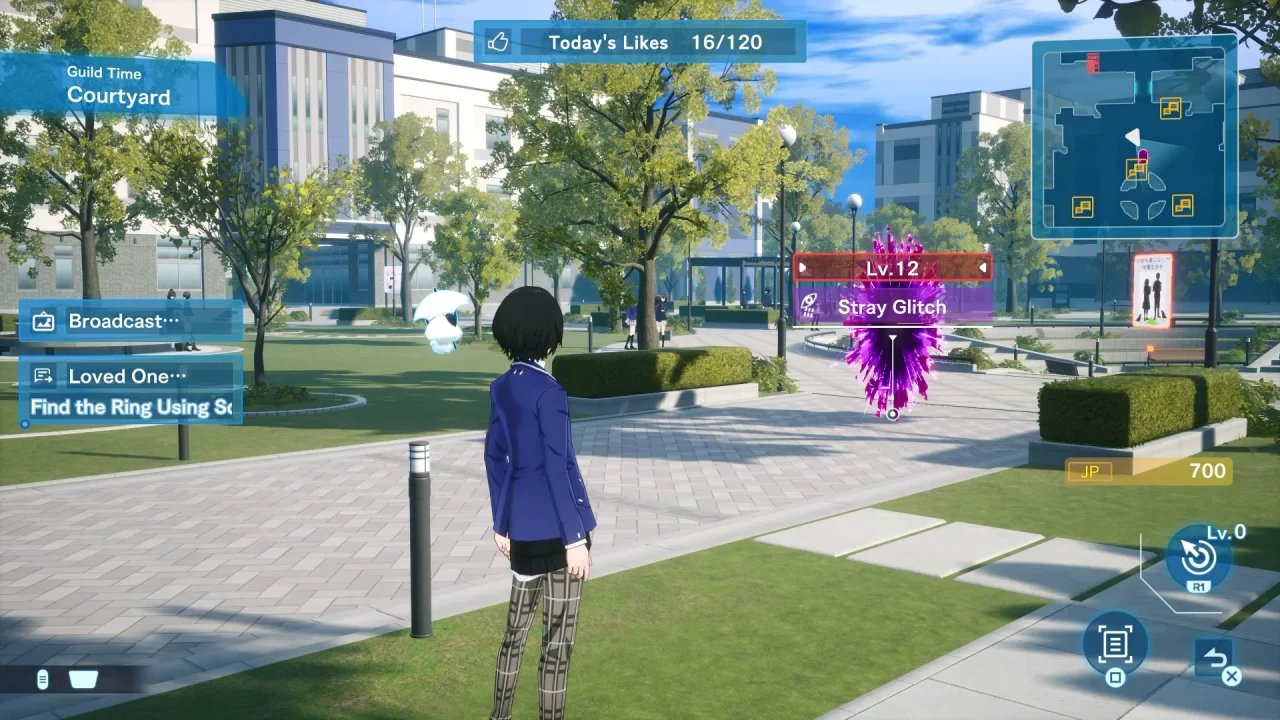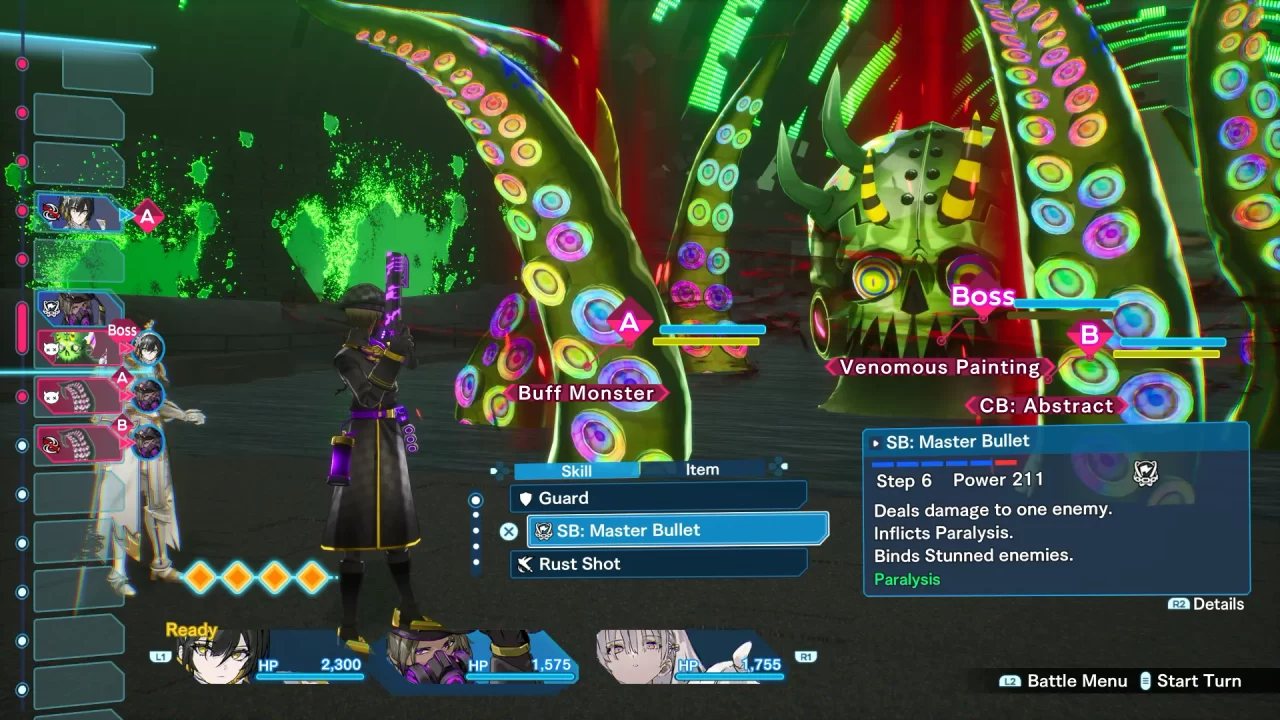I went into Varlet with high hopes, desperate to like it because the most recent FuRyu RPG I played, The Caligula Effect 2, was a pleasant surprise. It also didn’t hurt that Varlet’s graphics and UI visually reminded me of indie action RPG Eternights, a title I also enjoyed for its Persona-esque style. Sadly, while not a horrible game by any stretch of the imagination, Varlet is a primarily average, middling experience. While the story picks up enough steam at the very end to stop me from completely bemoaning the time I put into it, that narrative push comes understandably too late for anyone not wanting to invest excessive time to receive any semblance of a payoff. It’s a shame that, like so often with FuRyu games, there’s potential in Varlet that frustratingly never comes to fruition.
The plot of Varlet takes place in a technologically advanced city called Meifu City. The digital advancements infused into the daily aspects of life in Meifu City stem from the implementation of Johari, a cross-reality network. Unknown to most of the populace, though, is that the widespread usage of Johari is causing Glitches, actual dimensional spaces that open up between reality and cross-reality. Glitches are home to monstrous entities known as Desires, the will and wishes of a human being made manifest.
Our largely silent protagonist, quickly nicknamed Alt (short for “Alternate”) by his growing number of new friends, transferred to a Meifu City school that’s particularly dependent on Johari usage. He’s encouraged by his caring cousin Yuri to join the school’s Student Support Services (SSS for short) guild, which serves as a safe space for students to bring their troubles to for advice or problem-solving. Joining Alt in this endeavor are the responsible Noa, the carefree and laid-back Sota, the surprisingly sharp-tongued idol Aruka, the scholarly and artistic upperclassman Taki, the expressive-minded cinema expert Taiga, and the painfully shy first-year, Ema. As the guild tries to assist other students, they not only uncover Glitches but also gain a strange power allowing them to combat hostile Desires along the way. As conspiracies begin to take shape and the dangers escalate, what mysteries will they uncover lurking at the very heart of the Johari network, and will their combined might be enough to keep everyone safe?
It’s understandable if you find that plot summary somewhat familiar. A brief look at titles such as Persona (P4 especially, given the Glitch concept), The Caligula Effect games, and Eternights reveals similar narrative threads. Varlet’s story and its characters aren’t the most original, and one could argue that many of the archetypes found here were better executed in other RPGs. I didn’t hate the characters by any stretch, and I actually regretted that two in particular, Ema and Taiga, joined the party so late that you don’t get too invested in them, despite being two of the more interesting characters. Side note: I rather like Ema’s cyber samurai design when she fights! Aruka also stands out from other idol characters in similar games, given her snark in the English language version in particular. But most of the characters aren’t particularly memorable, remaining simply inoffensive and tolerable. Given Alt’s mute hero status for most of the game — an attempt to help players self-insert into his character — I struggled to understand why he was regarded as a leader, with everyone else frequently talking over him or even leading.
Alt only really has a significant impact when tasked with taking Johari’s personality tests throughout the game. You receive a surprisingly varied number of questions that you’re encouraged to answer honestly, which then rewards you with your dominant personality traits at that point in the game. These personality traits not only give you “hidden” dialogue options instead of limited default ones during some story scenes, but they can also impact battles by providing status boosts and effects. It’s an interesting concept, though I wish it found better overall utilization in terms of both plot and gameplay. As it is, the personality test questions feel like an unnecessary addition that doesn’t go as far as it could. Most dialogue options for Alt aren’t that different either, so I can’t say there’s much in the way of branching paths based on choice, which is something of a missed opportunity.
Personality tests aside, relationship-building mechanics are an expected part of this game type. Varlet also has a bond system, where Alt gets to hang out with other members of the SSS. Beyond seeing some slight expansion on their individual backstories through the character episodes and hangout dialogues, there isn’t much narrative impact to these events. The game encourages you to build up and maximize one character’s relationship over the others, becoming “partners” with your chosen party member. Doing so grants you the max number of Trust Points, which you can then spend on their personal skill tree: a chart where you spend points on stat-enhancing skills like raising defense or health points outside of standard leveling up. You can also enhance a character’s special skills so that they have added range or increased effects in battle (like turning Aruka’s heal ability into a groupwide one, should you acquire the Trust Points to do so). You can make your partner character a true powerhouse by maximizing the relationship, but this comes at the cost of raising the other characters’ Trust Points, making them arguably weaker than Alt and his partner in fights. Unlike games such as Persona or Eternights, the relationship-building doesn’t tie back into the main story, which is again something of a letdown. It isn’t the worst type of bonding system, but Varlet‘s is definitely not one of the best.
When you encounter a Desire in the Glitch dungeon map, a turn-based battle takes place in which you control three party members at a time. It’s pretty standard fare for a turn-based combat system, with you gaining access to skills, such as an attack with the Guard Break effect allowing you to break through a guarding enemy’s defenses to increase damage output and have them lose a turn. You can enter into a powerful combo chain at points depending on enemy status, and you do gain the ability to “interrupt” and skip ahead a turn if you have enough points for it. It can be strategically engaging, but again, there’s nothing particularly groundbreaking about the combat, either.
Once they encounter a Glitch in the main story, the SSS enter it to fight against hostile Desires. This portion of the game is often a multi-layered event spread out over a chapter or story arc’s episodes. The party progresses through a Glitch, fighting and solving map puzzles along the way. Glitch exploration typically unfolds in three segments, punctuated with save points at the start of the subsequent dungeon segment before encountering a boss at the final stage of the Glitch’s map. Dungeons aren’t exceedingly long compared to other comparable games, and the puzzles aren’t frustrating either. They can even be somewhat fun in later chapters as you receive more options when solving them, such as projecting temporary bridges to cross over space or even distracting Desires using a fake phone call. Still, the dungeons don’t necessarily stand out when compared across games, and the three-segment routine gets repetitive.
Speaking of repetitive, when not going through obligatory story dungeons, you usually have a portion of the game day devoted to helping Yuri with SSS tasks. This part of the game requires the party to navigate the campus’s limited areas, engaging in various mundane tasks such as setting up virtual posters for school events or searching for lost items. I’m genuinely surprised by how many students seem to be missing their shoes on this particular campus, given how often you uncover them! You can also enter random “stray” Glitches for small dungeon areas or puzzles to earn extra items or experience points.
However, since there isn’t much design variety, you can spot that the same trick that solves one stray Glitch repeats. You can also listen in on conversations between characters, updating your student records as you go with new tidbits of information from your outings. Beyond the SSS members and some of the central secondary characters in the main plot, it’s hard to remember or care much about the random NPCs in the halls, no matter what drama is going on with them. Once you’ve completed the tasks assigned for that outing, you can end it to receive a ranking for the thoroughness of your process. This setup then repeats constantly over the course of playing Varlet. I wouldn’t say this portion of the game is terrible, but it’s not really necessary and can feel tedious. It’s more akin to padding to make the game longer.
Visually, Varlet doesn’t sport the best 3D graphics and looks like it may have had a limited budget because it relies on gimmicks like only showing silhouettes of non-important background characters, having very similar enemy designs, using sound or narrative description to describe something happening off-screen, and other things of that nature. I didn’t mind that so much, though, and the visuals grew on me in an almost nostalgic way as I played. I also greatly liked the character artwork used for more story-relevant characters when they were speaking, especially how expressive they could be. The use of pretty CG illustrations at specific points was also a neat touch, especially since you can view them alongside movies through the Gallery after you’ve beaten the game.
Varlet’s biggest strength is probably its use of music and sound. The sound effects help convey scenes that might otherwise have no impact whatsoever, given the limited visuals, and the Japanese voice acting for the characters is also quite impressive and dynamic. The music tracks, particularly vocal songs like the opening and the final Glitch boss battle themes, were also notable. The English localization’s script-work is relatively good in terms of readability and is overall consistent in quality, even though I sometimes suspected that the English script might’ve been given a more peppery flavor to some of the original Japanese lines.
Truthfully, the biggest issue I had with Varlet was time management. It tries to cover a lot of ground in a short amount of time in its main story, often causing plot points that could’ve been explored more deeply to feel less interesting. The SSS quest segments felt like pointless filler, rather than strengthening the main plot. Additionally, the bonding mechanic felt wasted narratively. The final two chapters actually manage a surprisingly decent conclusion with some memorable plot reveals and developments, but it comes across “too little, too late,” given just how long it takes to get there. It’s a shame, as I actually did like the ending when I reached it. Still, I can’t imagine too many people having the patience to play through the rest of the game’s repetitive, mostly middle-grade loops to get there.
Varlet could’ve been another pleasant surprise by FuRyu, similar to The Caligula Effect 2, but sadly, it doesn’t reach that level. There’s some mild enjoyment here if you can temper expectations and be patient, but that isn’t something everyone can or should have to do. I think there’s potential here, should FuRyu decide to explore Varlet further in future game projects, but as it stands now? I’d advise waiting to get Varlet on a discount, even if you think you’re the target audience for it.






